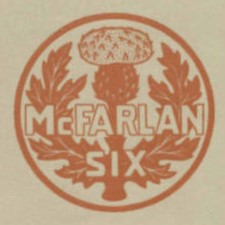
The Overland Automobile Company was an American automobile manufacturer in Toledo, Ohio. It was the founding company of Willys-Overland and one of the earliest mass producers of automobiles.
The Aerocar is an American automobile that was built from 1906 until 1908 in Detroit, Michigan. Backed by Henry Ford's former partner, coal merchant Alexander Malcomson, the short-lived company offered an air-cooled four-cylinder luxury car which sold for $2,800.

The Knox Automobile Company was a manufacturer of automobiles in Springfield, Massachusetts, United States, between 1900 and 1914. Knox also built trucks and farm tractors until 1924. They are notable for building the very first modern fire engine in 1905, and the first American vehicle with hydraulic brakes, in 1915.
The National Motor Vehicle Company was an American manufacturer of automobiles in Indianapolis, Indiana, between 1900 and 1924. One of its presidents, Arthur C. Newby, was also one of the investors who created the Indianapolis Motor Speedway.

Stevens-Duryea was an American manufacturer of Veteran and Brass Era automobiles in Chicopee Falls, Massachusetts, between 1901 and 1915 and Vintage Cars from 1919 to 1927.

McFarlan was a luxury American automobile manufactured in Connersville, Indiana, from 1909 to 1928, by the McFarlan Carriage Company and the McFarlan Motor Car Company.

The Marion was an automobile produced by the Marion Motor Car Company in Indianapolis, Indiana from 1904 to 1915.

Barley Motor Car Co. was a manufacturer of luxury automobiles in Kalamazoo, Michigan, and Streator, Illinois. It manufactured the Roamer automobile (1916–29) and briefly, the Barley (1922–24), and the Pennant (1924–25).

Single Center Spring Buggy Company was an American carriage and automobile manufacturer based in Evansville, Indiana. The Single Center factory manufactured the Zentmobile, Zent, Windsor, Worth, Single Center, Evansville, Simplicity and Traveler automobiles from 1903 to 1910.
The Rayfield was an American automobile marque manufactured from 1911 until 1915 by the Rayfield Motor Car Company, first in Springfield, Illinois and then in Chrisman, Illinois.

The Standard was an American automobile manufactured in Butler, Pennsylvania from 1914 until 1923 by the Standard Steel Car Company.

The Staver and Staver-Chicago was an American Brass Era automobile manufactured at 76th and Wallace Streets in Chicago, Illinois, by the Staver Carriage Company from 1906 until 1914.

Nyberg was the name of a brass era American automobile built by Henry Nyberg of Chicago, Illinois, in Anderson, Indiana, and Chattanooga, Tennessee from 1911 to 1914.

Schacht was an American marque of automobiles and High-wheelers from 1904 to 1913, in Cincinnati, Ohio. The Schacht Manufacturing Company, later renamed Schacht Motor Car Company produced over 9,000 automobiles. The company was reorganized as the G.A. Schacht Motor Truck Company in 1914 and production of trucks and fire trucks continued until 1938.

The Model Automobile Company was a brass era American automobile manufacturer located in Peru, Indiana from 1902 to 1909.

The Jackson Automobile Company was an American Brass Era automobile manufacturer located in and named for Jackson, Michigan. The company produced the Jackson from 1903 to 1923, the 1903 Jaxon steam car and the 1904 Orlo.
Two Brass era automobiles named Richmond were produced in Richmond, Indiana. A Steam car was made by the Richmond Automobile Company in 1902 and 1903. The Wayne Works produced the Richmond automobile from 1904 to 1917.

The Pilot Motor Car Company of Richmond, Indiana, was an American automobile manufacturer founded in 1909 and headed by George Seidel, of the Seidel Buggy Company.

Mitchell was a major brass-era automobile marque in Racine, Wisconsin, from 1903 to 1923.

The W. H. Kiblinger Company and the W. H. McIntyre Company produced Brass Era automobiles in Auburn, Indiana from 1907 to 1915.
























